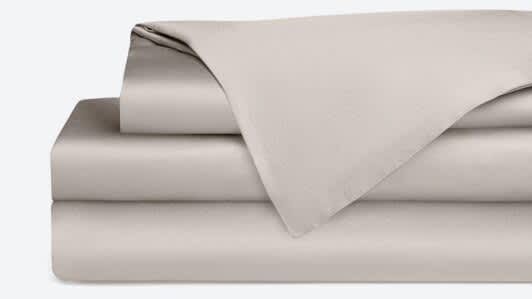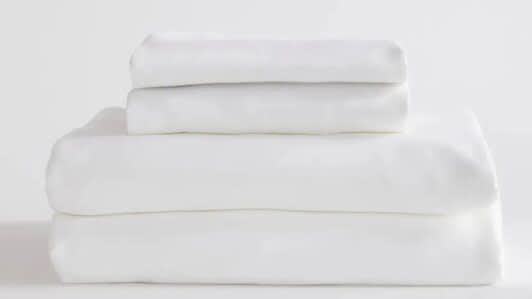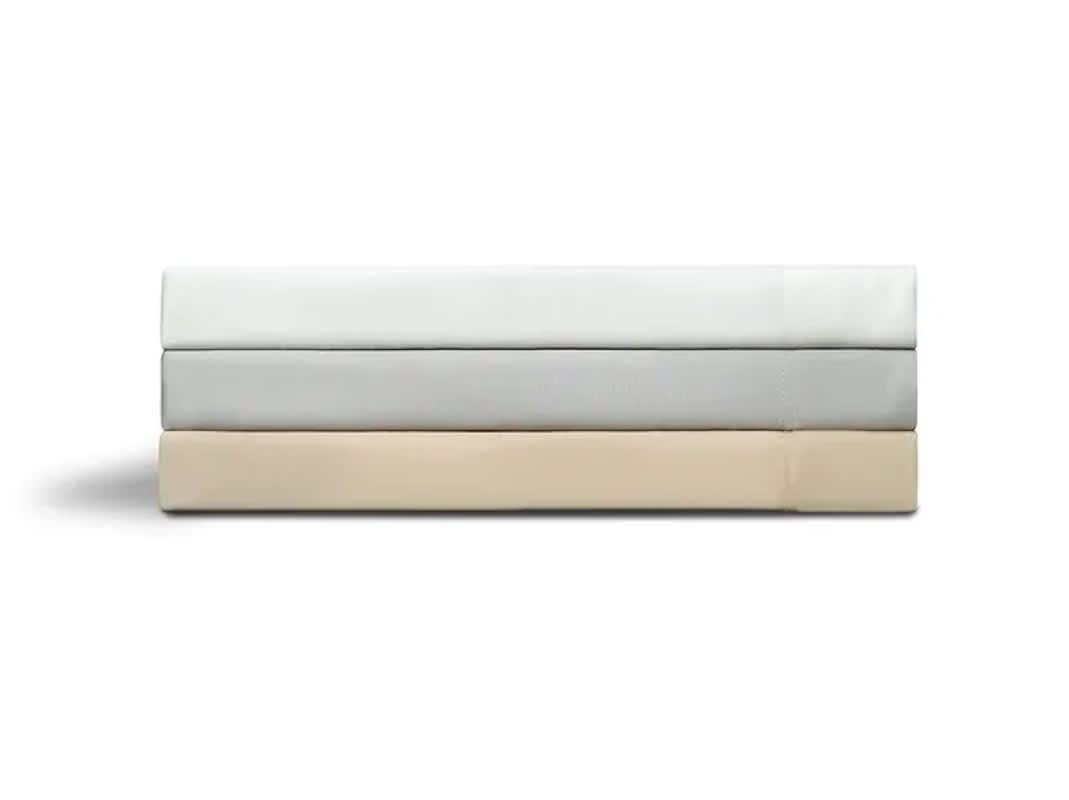On This Page
The Best Bamboo Sheets of 2025
Our Top Picks
-
Best Overall
Cozy Earth Bamboo Sheet Set -
Best Value
Quince Bamboo Sheet Set -
Most Comfortable
Luxome Luxury Sheet Set -
Softest
Brooklyn Bedding Deep Pocket Bamboo Cotton Sheets -
Best Overall
Layla Bamboo Sheets
Best Overall

Cozy Earth is a luxury brand whose products meet demanding standards for quality, performance, and sustainability. The Bamboo Sheet Set features top-end viscose made from bamboo. It has an appealing drape, excellent breathability, and an extremely soft feel.
Pros & Cons
Pros
- Supple and silky to the touch
- Promotes airflow and temperature regulation
- Brand emphasis on sustainable and socially responsible manufacturing
Cons
- Oversized fit may may feel too loose on lower-profile mattresses
- Price-point could be too high for some shoppers
Full Details
Best Value

The Quince Bamboo Sheet Set uses responsibly produced viscose derived from bamboo to create a soft, high-quality sheet set that sleeps cool.
Pros & Cons
Pros
- Made without harmful chemicals or pesticides
- Choice of eight solid colors
- 365-day window for free returns
Cons
- Sateen weave adds sheen but feels less crisp
- Not available in brick-and-mortar stores
Full Details
Most Comfortable

With its sateen weave and 400 thread count, the Luxome Luxury Sheet Set is designed to be soft and comfortable.
Pros & Cons
Pros
- High thread count and sateen weave result in extra softness
- Naturally moisture-wicking with excellent temperature control
- Available in a variety of colors
Cons
- Shorter 30-day return window
- Satin-like sheen may not fit all decors
Full Details
Softest

With their blend of cotton and rayon from bamboo, the Brooklyn Bedding Deep Pocket Bamboo Cotton Sheets offer an appealing mix of inviting softness and airy breathability.
Pros & Cons
Pros
- Soft and smooth to the touch
- Both cotton and bamboo can promote cooler sleep
- Pocket depth is able to accommodate high-profile mattresses
Cons
- Only three basic color options
- Return window limited to 30 nights
Full Details
Best Overall

The Layla Bamboo Sheets sleep cool and are a great option for hot sleepers looking for smooth sheets designed to promote airflow.
Pros & Cons
Pros
- Light and airy
- Silky-smooth hand feel
- Free shipping to the contiguous U.S.
Cons
- Only two color options
- May require ironing
Full Details
How We Test
We’ve tried every bamboo sheet set that we recommend, both in our sleep lab and in our own homes. Our trials include fabric exams that look critically at materials, weaves, and thread counts where we check to see how they feel and perform.
We lie on every set too — to see how well they breathe (an important consideration for bamboo sheets) and whether they’re comfortable to use. Our recommendations also factor in verified customer reviews because it’s important to understand how a sheet set holds up over time.
What Are Bamboo Sheets?
Bamboo sheets are made from the bamboo plant, which is a type of tree-like grass. Bamboo grows quickly and requires little maintenance, giving it a distinct advantage in terms of the sustainability of its production.
However, the process of turning bamboo into a workable textile involves soaking the harvested plant in a solution that softens and separates the fibers from the woody parts of the plant. Although this process can be intensive, and certain types of bamboo-derived fabrics involve the use of harsh chemicals, many bedding brands work to make this process as efficient, eco-conscious, and safe for workers as possible.
The final fibers may be referred to with a more specific name, such as bamboo rayon, bamboo viscose, or bamboo lyocell, depending on the specific process used to produce them. These fibers are very fine and light, with a woven texture that’s soft and lustrous. Bamboo sheets are known for being moisture-wicking and breathable. They also tend to be hypoallergenic and durable, provided proper care is taken during washing and drying.
There are restrictions surrounding what can be called bamboo and what can’t, but not all brands play by the rules. If you want real bamboo-derived fabric, look for companies that give specific fabric types rather than just saying “bamboo.”
Who Is a Good Match for Bamboo Sheets?
Bamboo sheets are usually smooth and moisture-wicking, so they tend to help regulate body temperature for hot sleepers. They can be a good choice for those with sensitive skin since they resist the buildup of allergens and also minimize friction against the skin thanks to their smooth feel.
- Hot sleepers: Airy, breathable fibers promote cooler sleep and draw sweat away from the body for added comfort.
- Sleepers who live in warmer climates: Whether you live somewhere that’s warm all year or just in the summer, bamboo is lightweight and breathable, making it a go-to fabric when the temperature rises.
-
People with sensitive skin or allergies: A glossy sheen helps skin slide over the surface of bamboo sheets, reducing chafing. The material’s hypoallergenic makeup also helps deter skin irritants.
- Pet owners: For people who share their bed with pets, bamboo is odor-resistant with a silkiness that helps prevent pet hair from clinging to it.
Why Buy Bamboo Sheets?
The structure of bamboo fibers promotes airflow, wicks moisture, and delivers significant softness. Visually, bamboo sheets often have a natural and luxurious-looking gloss. Bamboo sheets are a good fit for sleepers who want comfort and breathability without sacrificing durability or visual appeal.
Pros and Cons of Bamboo Sheets
Bamboo has a lot to offer in terms of feel and performance, but as with any type of sheets, there are certain drawbacks that shoppers should consider as well.
Pros
- Smooth and silky feel
- Elegant, glossy finish
- Superior breathability and thermoregulation
- Long-lasting with proper care
- Hypoallergenic and easy on sensitive skin
Cons
- Can be more expensive than other natural or synthetic sheets
- May require ironing after washing
- Production process can carry a significant environmental footprint
- May feel too light during winter months
What to Expect From Bamboo Sheets
Bamboo has performance and appearance characteristics that set it apart from other sheet materials. It’s especially well known for its softness, breathability, and durability.
| Bamboo sheets characteristics | Description |
| Feel | An exceptionally silky-smooth feel makes bamboo one of the softest, most comfortable materials for bedding. |
| Thread count | Bamboo threads are very fine and create a naturally soft and sturdy sheet at a typical thread count of around 300. Higher thread counts are not necessary for bamboo sheets to achieve optimal performance. |
| Breathability | The open internal structure of bamboo promotes airflow, giving it a lightweight feel and noteworthy temperature-regulating capability. |
| Durability | Bamboo fibers are quite resilient. With proper care, sheets made from bamboo can last several years. However, depending on the weave, the fine threads can be susceptible to snagging or pilling. |
| Ease of care | In general, bamboo sheets are easy to care for. The vast majority of them can be machine-washed in cold water and dried on low heat. Some sheets may require ironing to remove wrinkles. |
| Price | Although prices can vary dramatically, bamboo sheets are often more expensive than other natural or synthetic materials. Organic versions and those with added certifications are typically costlier than standard options. |
Are Bamboo Sheets Better Than Cotton Sheets?
Deciding whether bamboo or cotton sheets are better suited for you is ultimately a subjective decision and comes down to your preferences. Both bamboo-derived fabrics and cotton are light, breathable, and durable. Bamboo tends to be extra smooth with a subtle shine, while the best cotton sheets are more traditionally soft and buttery with a matte finish. There are generally more options for cotton sheets because of the diversity of types and lengths of cotton fibers.
I’m a hot sleeper and I love how bamboo sheets feel silky but they don’t trap heat. High-quality sets can be pricey, but I think their durability and performance are worth it.
How Are Bamboo Sheets Made?
While derived from a natural source, bamboo viscose is actually considered a semi-synthetic fabric because several chemicals are involved in manufacturing it. Once harvested, bamboo must be soaked in a solution that separates the bamboo fibers from the rest of the stem of the plant. These fibers are then spun into threads that can be woven into bamboo sheets.
Types of Bamboo Fibers
There are several different types of bamboo fibers that are made using slightly different manufacturing processes. The resulting fibers create bamboo sheets with subtle distinctions.
- Bamboo rayon: Rayon is a term for a family of semi-synthetic materials made from cellulose that has been extracted from a natural source, typically by using chemical solvents. It is then washed, dried, and spun into fibers. While wood pulp from eucalyptus trees is a common source of cellulose for rayon production, rayon can also be derived from bamboo.
- Bamboo viscose: Though sometimes used interchangeably with bamboo rayon, bamboo viscose is a specific type of rayon material that involves chemical processing with carbon disulfide. This chemical must be appropriately handled to avoid negatively affecting workers or the environment.
- Bamboo lyocell: With lyocell, the bamboo fibers are not chemically altered. Rather, a nontoxic enzyme dissolves the bamboo pulp. Overall, creating bamboo lyocell has less social and environmental impact, but fewer sheet sets are made with this specific bamboo material.
- Bamboo linen: Bamboo linen is made with a mechanical process rather than a chemical one, using bamboo fibers that are combed out and spun into thread. Bamboo made this way is also referred to as natural bamboo and generally has a rougher feel than viscose or lyocell.
Bamboo Sheet Weaves
Once bamboo fibers are spun into thread, they need to be woven to create bedding. There are several types of weaves used to make sheets, and each one has a distinctive look and performance.
-
Sateen: This is the most common weave used with bamboo sheets, as it emphasizes bamboo’s natural sheen and softness. Typically featuring a one yarn under, three or four yarns over weave pattern, sateen has a nice drape and silky luster.
-
Percale: Less commonly used with bamboo, percale has a basic one-over, one-under thread pattern that produces crisp, airy sheets with less shine.
- Twill: Twill creates a signature diagonal pattern that’s durable and pliable but slightly less soft than a sateen or a percale weave.
Last Things to Know About Bamboo Sheets
Soft, breathable bamboo sheets can feel great, but there are important considerations to keep in mind to make sure you’re selecting the best sheets for your needs.
How can you tell if bamboo sheets are high quality?
High-quality bamboo sheets use carefully manufactured threads and efficient production techniques to capitalize on the material’s natural softness and temperature regulation. Take into account the type of weave, pocket depth, care requirements, and brand reputation to get a more well-rounded picture of the sheets’ overall performance.
For sheets with a reduced environmental footprint, you can also look for brands using lyocell from bamboo or sheets that have eco-friendly or organic certifications.
What is the best thread count for bamboo sheets?
The thread count of sheets is often used as a kind of shorthand for quality. Unfortunately, it’s an easy metric to manipulate, with some brands using more strands of lower-quality threads to artificially inflate the total number of threads per square inch of fabric. High-quality bamboo sheets generally have thread counts between 300 and 500.
How often should you wash bamboo sheets?
Bamboo sheets can be laundered as needed, but keep in mind that washing sheets too frequently can result in faster deterioration. Taking proper care when washing them also extends their lifespan. Typically, you can wash bamboo sheets in a washing machine in cold water and then tumble dry, but it’s always best to refer to the manufacturer’s recommended care instructions.
Can you bleach bamboo sheets?
Avoid the use of bleach and harsh detergents when washing bamboo sheets. They can damage the fibers and impact the durability and longevity of the material.
